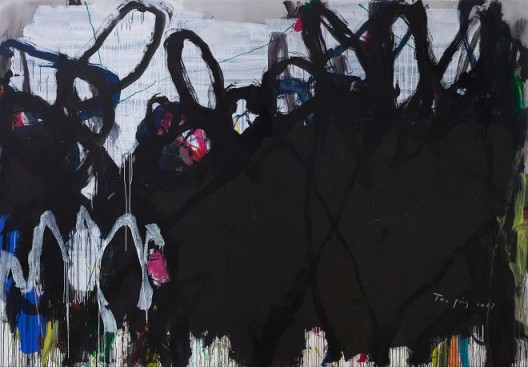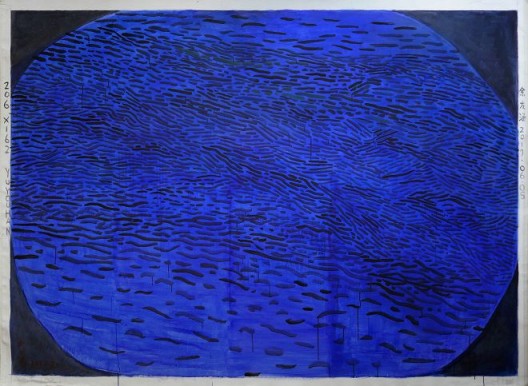6 Abstract Artists in China
Arario Gallery Shanghai
[Press Release]
Arario Gallery is pleased to announce the opening of a group exhibition entitled Graffiti and Calligraphy: 6 Abstract Artists in China on September 8, 2017. The exhibition presents six established Chinese artists, including Yu Youhan (余友涵, b. 1943), Ma Kelu (马可鲁, b. 1954), Qi Haiping (祁海平, b. 1957), Tan Ping (谭平, b. 1960), Huang Yuanqing (黄渊青, b. 1963) and Chen Guangwu (陈光武, b. 1967). With the artists’ being of different generations—born in the 1940s, 1950s to 1960s—each exhibited artist enters into calligraphic abstraction by means of their different opinions, approaches and viewpoints. By devoting themselves to shaping their own artistic values and refining their artistic language continually, their works simultaneously embody the essence of “Graffiti and Calligraphy” and yet display their maverick approaches.
There are two fundamental types of painterly actions in the exhibition. “Graffiti” refers to the painterly gestures of figuration, generally associated with unfolding colors in space, while “calligraphy” refers to the gestural movements of calligraphy, most often seen as linear movements from various types of brushwork. In terms of cultural attributes, “graffiti” is closer to Western artistic expressions, with a graffiti-like spontaneity and freedom, whereas “calligraphy” approaches the oriental visual composition within its own principles and controllable frameworks. In looking back at the Chinese ancient idea that “calligraphy and painting have the same origins”, this exhibition intends to equate “graffiti” and “calligraphy”, all the while continuing to reexamine the possibility that abstract art in the West and the East achieves the same end through different means.

Huang Yuanqing, Untitled, Acrylic on Canvas, 110 x 130 cm, 2014–2017
黄渊青,《无题》,布面丙烯,110 x 130 cm,2014–2017

Huang Yuanqing, Untitled 2017–10, Acrylic on Canvas, 120 x 160 cm, 2017
黄渊青,《无题 2017–10》,布面丙烯,120 x 160 cm,2017
Stemming from the aesthetics of Chinese calligraphy, calligraphic abstraction is one of the most important future developing directions in Chinese abstract art. “Graffiti” and “calligraphy” would manifest their potential independence in terms of the sense of form, sense of movement and sense of space, when calligraphy’s stipple and line break the limitation of its original shape. This new calligraphic abstraction is turning to be more untrammeled once parts are seen as an entirety, and processes as goals. In the meantime, it also has variations in rhythm together with its traditional skilled calligraphy. By abnegating the inherent ideographic function of calligraphy, “meaning beyond the image”, and “conceiving meaning as we forget its form” should be the core values for further develop the traditional cultural resources of Chinese abstract art as well as those of contemporary creation. Despite the limited exhibition scale, the exhibition presesnts a comprehensive summary of Chinese calligraphic abstraction and yet displays a far-reaching significance.
Yu Youhan started to research “stone-drum inscriptions” (石鼓文) for his abstract creation since the 1980s. Circle Series has become representative of his spirituality in an abstract art world as well as of his prestigious figurative art series over 30 years. Ma Kelu’s abstraction experiment started in the middle of 1980s; his abstraction paintings always maintain their instincts both psychologically and formally, with strong Chinese aesthetic and calligraphic interests. The artist also lived and persisted in creating artworks in America for more than 10 years. Among Chinese oil painters of a similar age, Qi Haiping’s calligraphy has attained a professional level, where he researches and explores calligraphic abstraction. The inner beauty of the running script and cursive script makes up his individual artistic language. Tan Ping studied in Germany in the late 1980s, and he has continued with his practice of abstraction over the last two decades upon his return to China. His multiple coating and fluid lines are his trademark painting approaches, in order to express the “nature of object” and “texture”. Huang Yuanqing initiates his creations from modern calligraphy. His delicate graffiti emphasized by the brushstrokes, color, rhythm, and composition embody the wisdom and taste of contemporary literati. Chen Guangwu is also a renowned modern calligrapher. His creation blurs the boundaries between painting and calligraphy. The visual elements of calligraphy—stipple and line—result in his further exploration of individual aesthetics.

Ma Kelu, Ada in Silver Purple, No. L-3, Oil on Canvas, 290 x 290 cm, 2017
马可鲁,《Ada银紫 No. L-3》,布面油画,290 x 290 cm,2017

Ma Kelu, Ada No. L-2, Oil on Canvas, 290 x 400 cm, 2016–17
马可鲁,《Ada No. L-2》,布面油画,290 x 400 cm,2016–17

Qi Haiping, Blue Sky After Raining No.15, Acrylic on Canvas, 200 × 150 cm, 2015
祁海平,《雨过天青15》,布面丙烯,200 × 150 cm,2015

Qi Haiping, Space Writing, Acrylic on Canvas, 200 x 50 cm x 24, 2016
祁海平,《空间书写》,布面丙烯,200 x 50 cm x 24,2016





